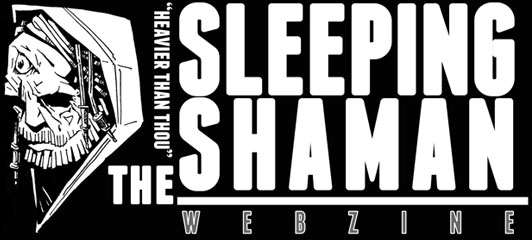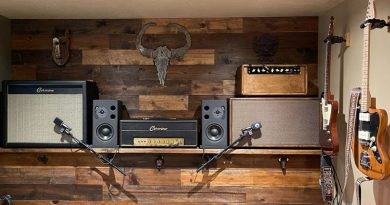In Search Of Tone: Marcos Garcia Of Here Lies Man
When I started this series, I didn’t know what type of answers I would be getting, or how the responses from the artists would be. Talking to Marcos Garcia from Here Lies Man was an eye opening experience. He went over my head a few times with all the knowledge about gear, but taught me an incredible amount. Not only that, he also had some amazing perspectives on songwriting.
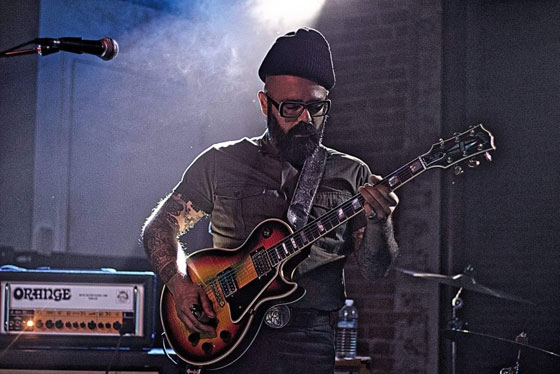
As you will learn below, Marcos sets out to capture a feeling, or a scene, as if painting a picture with his music. It’s an inspiring way to look at music and his work in Here Lies Man reflects that with precision. I appreciated talking in length with Marcos and I hope you feel as inspired about music as I did.
Thank you for taking the time to discuss your perspective on gear and songwriting.
It’s hard to find people that want to talk about gear. I’m all about it.
Let’s just jump right in with gear then. What kind of amps are you currently using?
I’m using tons of different amps just because it’s been that sonic exploration. One of the amps I’ve been thinking about lately is the Fender Bassbreaker. It’s kind of Fenders take on Marshalls take on Fenders original basement circuit and it’s really well done. They swapped the tubes out to EL 34’s instead of the 6L6’s the basement’s have or 5881’s depending. They discontinued the 50 Watt version which is silly because that thing rips so hard.
So, the ones that are on the rig are the Orange Rockerverb 100 Mark III and the Hiwatt Custom Super High 50. The one that was going to be called Bridge City Sound and will come out as Barton High Voltage. That model was called the Steel Bridge, it will have a different name when it comes out and gets reissued. The thing is nowadays I’m thinking more about the power tubes and if it has attenuation or power scaling.
I have some gear in New York for touring and, no one talks about it, but I think the Marshalls DSL sounds fantastic. The 100 watt that is, I haven’t played the lower wattage ones, but the 100 watt, I think it sounds great. I have a Marshall Origin which is good and utilitarian but I’m not so much of a pedal guy anymore. You can push it to get the power tube saturation but you have to really crank the shit out of it.
The thing that I learned throughout a long segment of the tone quest, what I really want to hear is the power tube saturation. The Pre-amp tubes make the guitar signal sound compressed. Any amp makes compression happen, which is pleasant to the ear, but if it’s overly compressed, it stops feeling dynamic and that’s kind of why I gave up on fuzz pedals for the essence of the guitar tone I was going for. Once my ear started to tune into what was really happening, versus what it is that I actually wanted, I had to move away from the fuzz pedals.
I still love them, don’t get me wrong as I sold a bunch, but I still kept a bunch. You lose the pick attack with fuzz. Everything is a square wave, so you lose the subtleties you get when you’re listening to the power tube saturation. The power tube saturation is obviously still compressed, but less, so it just has all of these overtones that are actually more pleasing to my ear, and then if you’re really driving the amp you get the same kind of sustain on a Les Paul let’s say, than you would with a fuzz pedal.
what I really want to hear is the power tube saturation…
Since you have moved away from fuzz pedals and rely more on your amps power saturation, what pedals are currently on your pedal board?
I’m not always maxing out the amp, I’m trying to get the power section to saturate. Part of how I’m doing that in Here Lies Man is hot pickups, so the output is higher typically. The guitar runs into a parametric EQ or boost. People debate the hot pickups versus the more lower/medium output. I get it, it’s only recently I started high output pickups (not active), but ceramic, sometimes Alnico 5 magnets. There’s something about the in your face feel from high output pickups that I like. You have this hot signal and you’re boosting that. There are all different kind of boosters. There’s a treble boost, that should be called a mid range boost because that’s what it really boosts [laughs].
It really depends on the room you’re in which is why I like the parametric EQ because I can sweep the EQ, 400 eats up a lot of real estate, so sometimes taking out a little 400 and bumping up above that 600-800 range is where the real throatiness of the guitar is. It gives the guitar a vocal quality and it cuts through because your ear is attenuated to hear your voice and high pitched frequencies first. So when you boost, it really pops out.
There really isn’t much drive coming from pedals, its sheer volume that’s pushing the amp into saturation. If you’re looking at an amp that has a master volume, then I’m not diming the gain. I’m pushing the volume without pissing too many people off [laughs]. It is better sometimes to have a lower wattage, like a 50 watt amp you can push the power section into distortion quicker than 100 watt. What I love about the Rockerverb is the built in attenuator. I max out the master volume and then attenuate it. The gain isn’t even super high because I’m getting it all from the power section. Using other external attenuators doesn’t sound great and can kill the tone a little bit.
Beyond the boosts and EQ’s, I use a delay pedal and wah pedal. I use those after the dirt. I know most people do it the other way, but if there is a little drive happening, having that go into the wah it becomes more dramatic. I used to run the fuzz into the wah as opposed to the wah into the fuzz. It becomes almost more musical by putting it before. I like the sweeping filter effect from playing keyboards. I put a filter on keyboards so I can get a filter sweep. That becomes more pronounced by putting the fuzz before the wah. The last thing on the board is reverb. I only use delay and reverb and I rarely delay as it’s more of an ‘effect throw’. I use it more as a cinematic effect, as a piece to connect two parts. I don’t know if you have seen us play live, but we will play a song, then connect the next song with an interlude to give your ear a break and continue that cinematic idea.
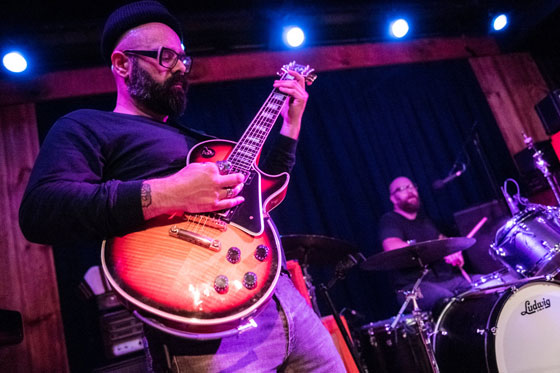
I learned about flat wound strings through you. Thanks for that. Can you tell me how you first began using them?
I was playing more jazz music when I was younger. Flat wound strings are common in jazz. They aren’t as bright, so jazz guitar players gravitate more to that darker tone. I love Jim Hall, I loved his sound. The sound of his guitar was so fucking dope. Have you checked out Jim Hall?
No, I’m going to though definitely.
He has such a great sound. There are so many guitar players that play flat wound and I never really switched. I don’t like a lot of high end. I like just enough. Cymbals and tambourines provide a lot of the high frequency sounds. The tambourine is called the magic instrument and all of those frequencies are moving really fast and your ear is attracted to those sounds first. The squeaking of the guitar strings are distracting from the music because of the high frequencies you’re hearing. I think you can use those sounds artfully too, I just like the main tone I’m going for and find it distracting.
Lastly, we arrived at guitars. Do you have one main guitar use use most often?
I have a specific 10 that I like [laughs]. I’m a Gibson Les Paul guy, that feels the best to me. I don’t know man, I started getting into Gibson Explorer’s however and I found a Gibson Firebird unused and I really like the neck on that, but still getting used to the pickups. They sound Fender Telecaster like to me.
I like Les Pauls, SG’s, Explorer’s, I’m a Gibson guy. I bought a Fender Jazzmaster off a friend of mine. I want to use that for recording other projects and its fun because it has the tremolo on it. I really like mahogany, big slab of wood, chucky maple cap kind of dude. It’s the sustain. When you really drive the amp you can really make the guitar sing.
I’m a Gibson Les Paul guy, that feels the best to me…
You mention earlier, on your new album you aren’t using any fuzz pedals? That’s interesting because although I feel your earlier albums may be a little heavier, the tones you create in Ritual Divinations, I would have assumed some sort of fuzz was used?
So you’re saying that you think the earlier record sound heavier because some people think the opposite. The thing is I don’t know what ‘heavier’ is at the end of the day. I don’t know what that means, but I know what it feels like in the room. When there are four to eight speakers moving air that feels ‘heavy’ no matter what the hell’s going on. The thing is when you’re really pushing the power section of an amp, it’s clipping the sound wave. That’s what a fuzz pedal is doing. A fuzz pedal is trying to emulate essentially, a fully maxed out amplifier, where the sound wave is clipped to be square. Fuzz is a square wave, but with that square wave you lost a lot of the dynamic that is still there when you’re pushing the power section of an amp. It was difficult to wrap my head around at first.
There are overdrive, distortion and fuzz pedals and what they are emulating is mild clipping, more clipping and a completely clipped sound wave. I realized that the completely clipped sound wave (fuzz) is effective if you use it as a device, not as the main tone. Same thing with distortion pedals; it’s just not the same as when you’re fucking blast an amp [laughs]. When you’re blasting an amp there is a calculation of how many people you’re going to piss off. When you play heavy music, that’s what you’re up against. Who are you going to piss off, how many of them are there going to be and do they have the power to get you to stop doing what you’re trying to do?
For most of my career as a professional musician, I never turned up my amplifier past three or four. I had no reason to, especially playing afro beat in a normal venue. Playing at three or four on a fender twin is considered loud. So the first time I cranked up an Ampeg V4 was at our rehearsal studio. I was playing it out of an 8×10 Ampeg bass cabinet. The sheer volume of it, because of 8 speakers, penetrates your body. Once I felt that, I never wanted to go back. How can I go back, I know what this feels like and it’s an ecstatic kind of feeling. I can feel the hairs on my arm moving from the sound waves.

This instrument that I have a respectful, tender relationship with had escalated. That’s why they call it an axe [laughs]. It felt like I was wielding this machine that can literally make my organs move. It was that loud. That’s an addictive feeling, like a release. Most people don’t want to be around someone like that however [laughs].
I was at our rehearsal studio back when I was living in Jersey City. I was trying all these techniques to make my sound as big as possible. For instance, using an octave pedal to have an octave above and below. I was using a MIDI and running a synth through it, which has even more fucking gain than a guitar. It has a higher dB output. There were literally dudes from different studios knocking on my door saying ‘hey man, I’m just trying to record, or rehearse something and I can’t hear myself, can you turn it down’. That was at the beginning of this journey of how loud can I get. I’ve reeled it in since then.
It’s been a lot of years and a lot of money spent on experimenting. Every penny I ever made always went back into the studio. When I would make a new record, I would collect new gear for that record and sell the old gear from the previous album. Some things would carry over. With Ritual Divination, there were a lot of amps I wanted to try out. We tested them in the studio, some worked out and others didn’t of course. I wanted to use one of the super high amps I mentioned earlier, but I didn’t have the prototype in hand yet. It didn’t arrive until the beginning of last year. I got a lot of regular amps as well, like the Hot Rod Deville, that thing sounds pretty nice. I don’t use the drive channel so much. I don’t know if any of that was helpful.
the first time I cranked up an Ampeg V4 was at our rehearsal studio. I was playing it out of an 8×10 Ampeg bass cabinet. The sheer volume of it, because of 8 speakers, penetrates your body. Once I felt that, I never wanted to go back…
Yes, it was definitely helpful. As you can see I have a Boss Katana 100 watt practice amp but never come off the 0.5 watt setting because I have 2 kids yelling at me to turn it down.
That’s what I’m saying, it’s always an equation with who you’re going to piss off [laughs].
In Here Lies Man you create some really unique and original music. What is your writing process like?
I listen to music as research almost. It’s hard for me to passively listen to music. Sometimes I can, but for the most part I’m picking apart the drum sounds, and whatever other sounds I hear, as well as the production quality. It’s not always relaxing [laughs]. I can listen to classical music easier because it’s harder to wrap my head around and pick apart. My main inspiration are old west African bands. Everything else is being informed by that. I was listening to Tame Impala to study his production techniques and drum programming. For example, how does his snare and kick drum sound and listening to the bass.
The way I write is that I write a little bit at a time, over the course of a year or so and put it all together at the end. Every time I go into the studio or just pull out the guitar, if there is some inspiration in that moment, I will record it on my phone. I will record myself playing and that may turn out to be the A section. While playing that A section, then sometimes the B, C and maybe even a D section will emerge. Sometimes that happens faster than at other times.
In that moment I will give it a title based on how I was feeling, or seeing in my head. I find that giving it a title will give the song direction for later. I will then meet with Jeff and run through the parts of any given tune. We then arrange it and sometimes we will have the mic’s set up and record a play through. That’s the basis for the demo. We will track the guitar and drums and I’ll write the keyboard and the vocal parts. I’ve already laid out the next Here Lies Man record. I don’t know when we will be able to record it due to COVID, but the ideas are all laid out.
When writing a song do you create the music first or come up with lyrics?
I’m not into song writing so much anymore. What I mean is in its traditional form where there is an introduction, verse, chorus, bridge outro. That sort of thing. I got away from that a while ago. I felt like it started to feel forced after a while. That’s what I love about non pop or African music. In Afro-beat it doesn’t have to be that way. You’re going after a state or mood you want to create, induce a brain waved pattern essentially. I’m more comfortable writing with an artistic approach rather than a commercial approach. I am interested in scenes, like every piece of the song has imagery and I want to be capturing that, or at least try and suggested that instead of telling you a story in three and a half minutes. Some people are really good at that, but for me it’s not my favorite thing to do.
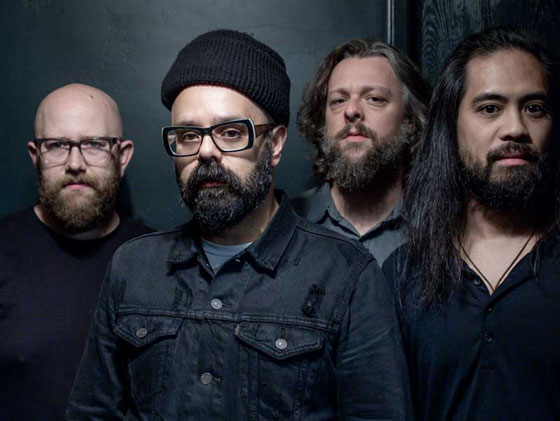
With a finite amount on chords/notes how do you create unique ideas without repeating yourself or others?
There are times where motifs arrive. Everything that I have done in the last 17 years, there are little things that reference each other. It’s self-referential. If you listen to the first Chico Mann record to the last Here Lies Man record, you might here certain motifs come up because that’s part of my little musical universe.
As far as creating unique music without repeating myself or others, well, I don’t really know how to answer that. You ask me this question, but you only use a certain amount of words in your vocabulary. How do you not say the same things? Sometimes you do in your life. But, everyday you manage to string them together in a new way and you have different thoughts, it’s a continuum. Creating music is the same idea. I will say, all the music that I have written is based on the clave. Because I have this organized rhythmic principle, the beauty of that is that it’s inexhaustible. It’s fractal in nature. It just keeps on giving for thousands of years, that’s been the case.
I cannot tell you how many hours, countless hours, of scouring the internet to just realize how confusing it all really is…
I really like your perspective on music and gear. You have taught me a lot already and showed me a new way to approach writing music. Thank you!
I cannot tell you how many hours, countless hours, of scouring the internet to just realize how confusing it all really is. Then when I started to get a little bit of clarity, finding that very specific thing I’m looking for, now becomes even harder. I want to start designing some stuff. You know who I really like, Wampler. Listen to that guy. He knows what he’s talking about. His pedals are fantastic, he shares information and he’s so smart. I like what he’s done and he’s a tone wizard. I learned a lot just by watching his stuff.
It depends on what you’re trying to do. Everyone is different and don’t get me wrong, I still love pedals and sound designing with pedals, but for this one specific band, for these specific recordings and for the live shows, I’m trying to get this other sound and had to go through a bunch of different experiments to get it. Some days I felt like I got it and others I’m like damn, I didn’t quite get it. I think I’m the only person, for example, I’ll think damn today I went a little overboard with the midrange. It’s like anything else though, it’s just a process and its fun to be in that rabbit hole. I think I want to get more into design and collaborating on things because there is stuff I wish was out there but doesn’t exist.
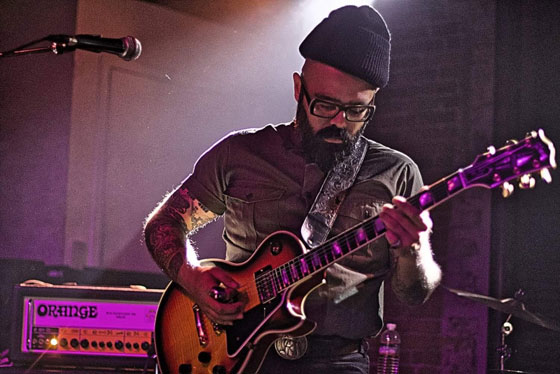
Do you have any custom gear made for you?
That Bridge City Steel Bridge, I had that customized a little bit. I had them dial in the midrange in the EQ section. It’s now a push/pull and you can shift the midrange frequency that gets boosted when the mids are turned up on the amp. I had them put in a Marshall flavored front end and a Hiwatt power section. So it’s really loud and best used outdoors.
I have many off days when playing guitar. If you have an off day, what do you do to get inspired to play again?
I can totally relate. Sometimes I’ll hang out on one chord and strum that. Usually a minor, or major 7th chord. The 7th and root are so close together that you can start hearing the waves and how the clash. It’s usually enough to put me into a relaxed state. When you’re making yourself frustrated because you’re not feeling inspired, you need to change the brainwave activity. It’s not hard to do. Some people meditate or go for a run. I can get lost in those sounds/waves. Sometimes it’s as easy as just trying again later. I’ve been there thinking this sucks and I’ll put it down and revisit it later with a fresh mind.
what is the point of playing guitar? Why even pick it up? For me its home. I just want to be home…
You have to ask yourself, what is the point of playing guitar? Why even pick it up? For me its home. I just want to be home. I don’t have to accomplish anything. When your home, you don’t have to be cleaning or anything, the whole point is you can relax there. I don’t have to write something every time I pick up the guitar. Sometimes it’s nice to play that chord and get lost in it.
The key is to really listen. You can play for hours just listening to one chord. At least I can [laughs], I took a lot of psychedelics as a kid [laughs]. Just kidding. The point is the simple, things can get lost on us but can be so beautiful. They get lost on us because there is an agenda that we have. Telling ourselves we have to be accomplishing something. You’re missing the most simple beautiful thing. We have these twelve tones that we can make so many different sounds, and conjure these feelings. Don’t lose that.
Thanks to Marcus for the taking the time out to talk about guitars. Here Lies Man are currently supporting their latest album Ritual Divination that’s out now via RidingEasy Records.
Label: RidingEasy Records
Band Links: Official | Facebook | Bandcamp | Twitter | Instagram
Interviewed by: Josh Schneider
